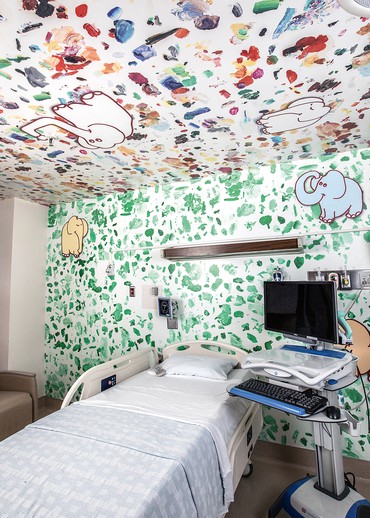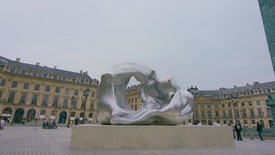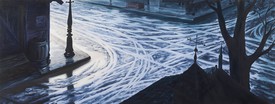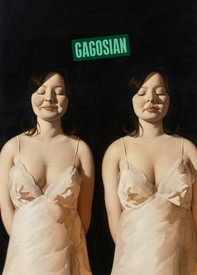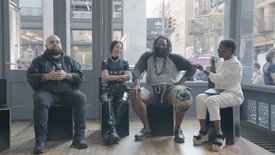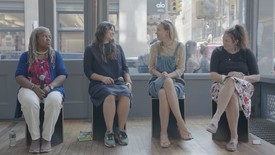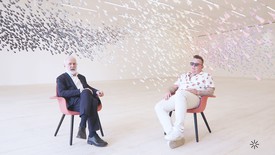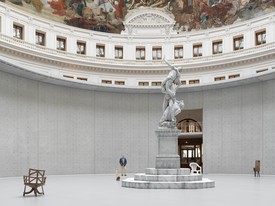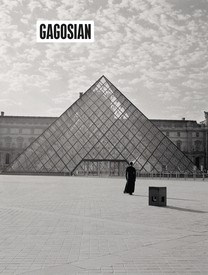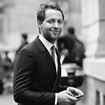
Derek Blasberg is a writer, fashion editor, and New York Times best-selling author. He has been with Gagosian since 2014, and is currently the executive editor of Gagosian Quarterly.
At the most fundamental level, a children’s hospital is designed to make young people feel better. We know many traditional ways of doing this: clean beds, fast-acting medicines, life-saving surgeries, nice nurses. But what of children’s mental health when they’re in the hospital? What about the things they see and they’re surrounded by? Enter RxART, a nonprofit organization whose mission is to help children heal through the extraordinary power of visual art.
RxART by the numbers: in the past sixteen years, the organization has completed nearly forty projects with sixty artists in hospitals throughout fifteen cities in the United States. Diane Brown, a former pre-med student turned New York-based art dealer, started the organization in 2000 with this mission statement: “We commission exceptional contemporary artists to transform sterile healthcare facilities into engaging and inspiring environments full of beauty, humor, and comfort.” By this year, RxART will have reached over 1,000,000 patients and their families.
Derek Blasberg discussed RxART’s good works with Brown and artists Dan Colen, Urs Fischer, and Jeff Koons.
Derek Blasberg How did RxART come about?
Diane Brown When I first started RxART we were installing framed artworks in patient rooms, corridors, and treatment and waiting rooms. We and the artists we work with have become increasingly ambitious, and we find that in most cases we can make the biggest difference by creating immersive environments. This includes projects like Jeff [Koons]’s dramatic redesign of the CT-scan suite at Advocate Children’s Hospital in Oak Lawn, Illinois. Jeff completely transformed the scanner suite, creating “wallscapes” for three walls of the suite using his iconic imagery of hanging heart, balloon dog, and pin-the-tail-on-the-donkey. Once the scanner and walls were transformed, Jeff suggested that a colorful floor would complete the project. He was right.
Jeff KoonsI would hope that maybe a child would come to this room and maybe get a little smile, and feel, “You know, this isn’t gonna be so bad after all and I may actually enjoy this part of it.” Having monkey faces on the scanner I think creates an optimistic situation, something a child won’t be frightened by. It feels more like an amusement-park ride, a fun experience, not something to be scared of.
DiBrThe scanner suite was an especially important project for me personally. In early 2000 I underwent a CT scan; I wasn’t afraid about what they might find but the environment was scary, it was cold and sterile feeling. I wanted to get out of the room, but that was not an option. Looking up at a totally white ceiling, I began imagining an artwork, eventually becoming completely absorbed by this fantasy. Then the test was over—I felt like I had been out of the room. I decided that I wanted to help others escape the hospital, even for a few minutes, in their imagination.
At the time of the scan I’d been a gallerist for sixteen years and was working as a private curator. I began to ask my friends and colleagues—curators, critics, collectors—“Do you think I can put museum-quality art in hospitals, pay the artists, and not charge the hospitals?” Everyone thought I was crazy. Agnes Gund said, “Try it!” Her encouragement was enough for me to start.
Dan ColenRxART feels very tied to my own beginnings in the art world. Maybe a year or two after my first show, Diane asked me to be a part of one of the first RxART coloring books. I was very honored to have been asked—to be included in something a group of artists were participating in was very exciting for me. A year or two after that I did the rock-paper-scissors puzzle with RxART. I love that thing—I have vivid memories of signing those boxes late at night. I was really in a groove and left some great anecdotes on those boxes.
DeBlDan, you did a building in New York, an enormous project at St. Mary’s Hospital for Children, in Bayside, Queens. What was it like to do something nearer to home?
DCI’d never been there before. Doing a hospital project in New York was a very exciting possibility for me. Both sides of my family have been here for many generations; I have cousins in every borough and suburb. To have an impact on something like a hospital, which to me seems so far outside of the art world, has been very fulfilling. A lot of it has to do with feeling the city has given me and my family so much for so long, it feels like a more direct way to give it something back than just a show at an art gallery.
DeBlHad any of you had experiences in hospital pediatric units?
DCI had a virus when I was very young in which I lost my motor skills. I remember having to go to the hospital every day for a few weeks to have blood work done. I hated it—the needles, the hospital vibe in general, it was all pretty scary. This is obviously nothing compared to what the kids are going through at St. Mary’s. It’s so important to have places that specialize in caring for children. They undergo so much pain and fear and discomfort—to have a staff and a facility geared toward their needs, which are much different than an adult’s, can have a hugely positive impact on their experience.
Urs FischerI once spent two weeks in a children’s hospital when my daughter was in intensive care, I was next to her bed the entire time. And I saw these other families—some of them lived there for months. They’d give up their jobs, they’d give up everything to be with their children. Also, both of my parents are doctors and I grew up in hospitals, so I was always very aware of the sense of pain. I believe that what you see can cheer you up, which is the whole concept of RxART. Being in a hospital is brutal, both on the kid and on the parents.
JKArt can make something a little more pleasant and soothing, putting children in a healthy state of mind. They’re in very vulnerable moments. Art can be reassuring, giving them a sense of future and optimism.
DeBlTalk to me about your concepts in the hospital.
JKA lot of my images have a childlike quality to them, or at least people say that. I looked into different images from my past to see if any were appropriate. This just seemed like a wonderful opportunity to do something for when children are in a very stressful time, to create an environment that’s a little more cheerful. I’m aware that the environments in facilities can really affect how things feel as they’re taking place. I’ve been to children’s hospitals and seen murals, and you get the sense that they’re not such daunting places when there’s more color. It helps to create a sense of community, the feeling that you’re not going through this alone.
DCI’d been making abstract paintings for a few years using photographs I’d taken of falling confetti. I hadn’t managed to satisfy my ambitions with the concept by simply making those paintings. When Diane approached me I knew immediately how perfect an immersive environment related to the confetti imagery would be. At its most basic, the series and its translation in the hospital is very bright and celebratory. But I’ve also always been attached to something more serious and melancholy in this body of work, which is important both to my own and I think RxART’s intentions. My goal was not just to create a playful environment but to bring a real art experience into the children’s lives. The work was to allow for a multifaceted experience, which I think it does.
UFThere were various options. I thought if you had a lot to look at, rather than one thing, that would be good if you were lying in bed. My childhood dentist had this weird poster right by the dentist chair—it was nice to have something to look at. The elephants came in because for an RxART fundraiser two years ago I made elephants for the invitation and the decoration. You want the children to have as much to look at as possible—something cheerful when the walls behind their beds are full of machines.
Art can make something a little more pleasant and soothing, putting children in a healthy state of mind. They’re in very vulnerable moments. Art can be reassuring, giving them a sense of future and optimism.
Jeff Koons
DeBlDiane, is there a specific concept that you look for in these collaborations? Or do the artists have free reign?
DiBrWe don’t charge the hospitals. We raise money to pay for every installation, including all fabrication, installation, and travel costs. We try to select artists who are appropriate for the demographic and geographic patient population, as well as for the particular unit in which they’ll be working. We don’t tell the artists what to do, but they all understand that they’re working to make a pediatric-hospital environment a more inspiring place. We do ask them to submit preliminary drawings, which we in turn submit to the hospital for approval. The staff of the hospital will be living with the work and they have to be happy too.
DeBlDid you see any of the kids when they were in there? How was that?
DCI was there for a music class one day. It was pretty amazing to see that happen in that environment. There was a lot of joy in the room—totally uninhibited dancing, singing, and instrument playing, the ideal activities to happen within my project.
DeBlThere’s nothing more bittersweet than doing something for children. How did you feel when this project is completed?
DCDiane and I had worked on this project for five years. There were many times when I felt it was slipping away, and was too ambitious for the hospital context. She and I were both very committed to it, and to finally realize it was one of the most satisfying moments of my career. It’s a permanent installation in an environment the children visit daily. It doesn’t feel “complete” to me—it feels like it’s just the beginning.


